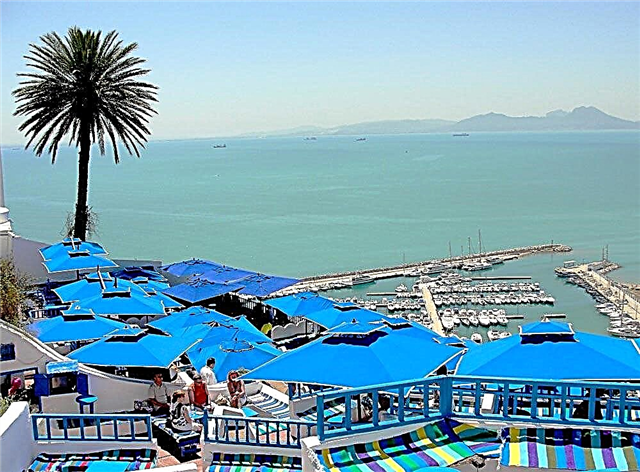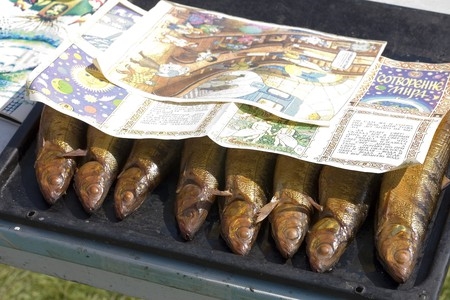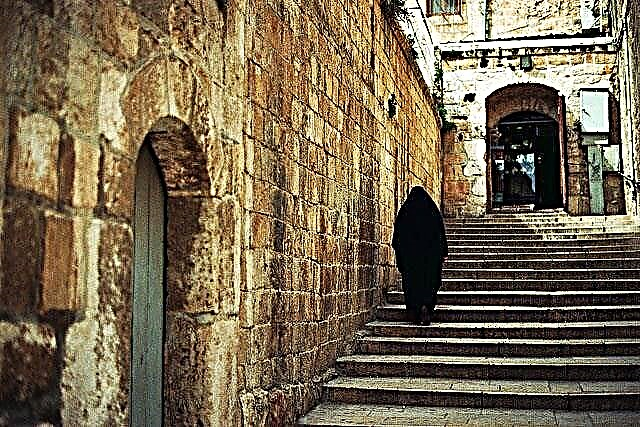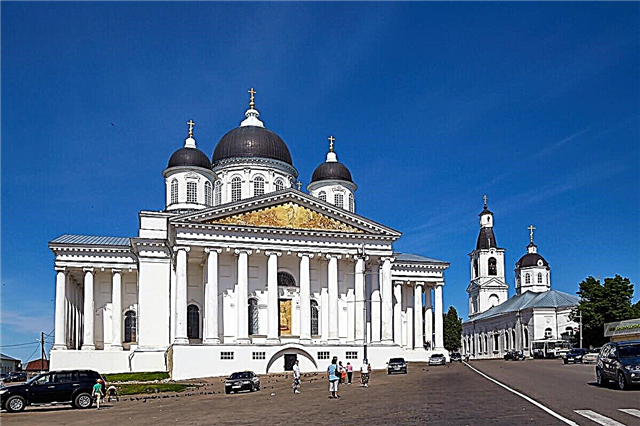Either the provincial town is so small, or there are so many temples here - but Arzamas has remained the city of ringing bells for many years. This feature gives the local atmosphere a certain spirituality and sublimity. Most of the churches of Arzamas are so ancient that they have undergone significant transformations over the history of their existence.
But they still keep the memory of past events, including the 1917 revolution. It was then that many temples were desecrated and destroyed. Today, Arzamas again shines with dazzling domes, having revived over time its main Orthodox wealth.
Active churches and cathedrals of Arzamas
The most famous and popular temples of the city.
Resurrection Cathedral
The temple standing on a hill is the pride of the city. The cross-shaped cathedral is striking in size. Its construction began in 1814, after the war with Napoleon. In the USSR, on the wave of atheism, the cathedral was subject to destruction, but as a result, an anti-religious museum was set up in the building. By the end of the Second World War, the building returned to its original function. A distinctive feature of the temple is the unique painting technique and icons with an ancient history, the most valuable of which dates back to the 16th century.
Address: Arzamas, st. Upper Embankment, 11
Website: arzblag.ortox.ru

Church of the Icon of the Mother of God "Life-giving source"
It was one of the first churches in the city to be heated. Opposite there is a summer temple, where services are held during the warm season. The church is more than 200 years old, before it there was also a church on this place. Throughout the history of the building, it has housed a dormitory and even a sports club. The religious status finally returned to the church only after the Great Patriotic War.
Address: Arzamas, Cathedral Square

Temple of the Kazan Icon of the Mother of God
The church was built in 1792. After the revolution, the parish was inoperative and was abandoned. In 2002, the building was restored and began to be used for baptismal ceremonies. There is a large font inside. Everyday divine services are not held here, services are conducted only on major Orthodox holidays.
Address: Sovetskaya, 1 B

Church of the Annunciation of the Blessed Virgin
The first brick of one of the oldest churches in the city was laid in 1775. The temple is part of a male monastery. Like many temples, during the revolution, he suffered severe destruction. The room was used for fuel storage, as a student residence and a savings bank. Many icons were taken out of the USSR. Only in 2004 did the church open its doors to parishioners again.
Address: Krasnodar, Sergius Square, 1
Site: ar-mon.ru

Arzamas courtyard of the Seraphim-Diveevsky monastery
The courtyard, which belongs to the nunnery, currently houses two churches. One of them is currently in operation. The exact date of construction is unknown. It is assumed that an old church stood on this territory back in the 17th century, and the current building continues its history. Today, valuable images are kept here, and people come to venerate the holy relics. The second temple is currently under construction.
Address: Lenin, 43

Church of the Epiphany
It is located on the territory of the Nikolaev women's monastery. The first church building on this site dates back to the 17th century, after which the temple was burnt down in fires or destroyed several times. The latter was built in 1811. During the revolution, there were shopping stalls in the church. The clergy was dispersed, but some of the icons were saved and preserved for posterity. In 1994, the building began to be restored, and today it has been completely restored.
Address: Komsomolsky Gorodok, 2
Site: nicola-arzamas.ru

Church of the Vladimir Icon of the Mother of God
A new church was erected on the site of the emergency parish of Zosimov at the beginning of the 19th century. It was built with donations from parishioners. Before the revolution, the building successfully served the laity, and in 1929 it ceased to operate. A bakery was equipped in the building, and the interior was plundered. Valuable icons were sold, and the monks were expelled. In 2003, the building returned to the bosom of the church, and services have been held here since 2015.
Address: Arzamas, Lenin street, 17 A

Church of the Descent of the Holy Spirit
The construction of the church began in 1752, but was first consecrated 25 years later. The church was consecrated for the second time due to a global restructuring in 1833. Its appearance has changed dramatically and approached the classical style in architecture. After the revolutionary upheavals, the church was given over to a printing house. And in 1995 the building was renovated and re-consecrated.
Address: Arzamas, Yuri Gagarin Square, 11

Church of the Icon of the Mother of God of the Sign
An elegant building in 1801 during the hard Soviet times for Christianity served the city as a planetarium. Since 1931, the premises no longer belonged to the clergy and were periodically used for state needs. The Church of the Sign, as the parishioners call it, was restored in 2006. And since the fall of 2010, divine services have been resumed in it.
Address: Arzamas, Yuri Gagarin Square, 9

Church of St. John the Evangelist
It is believed that the church was built by order of Tsar Ivan the Terrible. More than a century later, the wooden temple was replaced by a more practical stone one. The church survived the Red October and was still active for some time. But in 1935, half of the premises were set aside for a warehouse. And 6 years later, at a collective farm meeting, the final verdict was passed on the temple. In the 70s, the building turned out to be useless and stood in desolation until 2003.
Address: Solnechnaya, 36 A

Church of St. Andrew the First-Called
Built in 1793, this church was the smallest in Arzamas. Over the years the parish has been improved by the efforts of the parishioners. Thanks to donations, by 1917 the church acquired a rich decoration and began to stand out against the background of other temples. Soon the revolution thundered, and the church was confiscated from the people, antique utensils and gilded icons were confiscated. 12 years later, the Pioneers' Club settled here, then a circle of motorists. In 2005, the church regained its appearance.
Address: Vladimirsky, 26

Temple of the Lord's Entry into Jerusalem
1777 is considered the year of the beginning of the construction of the temple. In our time, the building is not in its original form. At the end of the 19th century, a fire broke out in the church, as a result of which the building was almost completely burned out. The newly rebuilt church worked until 1929. In Soviet times, the parish was used as a power station. Later there were garages here. In 2004, the neglected temple was given a second wind, and now it operates.
Address: Nagornaya, 1 A

Temple of the Tikhvin Icon of the Mother of God
The building shares the territory with the old churchyard. The church was opened in 1777 and gathered parishioners for Orthodox festivities not only from the city, but also from the surrounding area. The image presented to the church by a local merchant was considered the unchanging shrine of the temple. In the era of the USSR, the temple was taken under the building of the morgue, which was convenient - after all, it stood in the city cemetery. In 2010, the temple was reopened after a series of renovations.
Address: Sechenov, 2 A

Church of the Life-Giving Trinity in Kirillovka
In the area of the present village in 1824, a brick church was erected, popularly called Trinity. The entire district raised money for this project, but the church served the people for exactly 100 years. The revolution brought devastation - the bells were removed and destroyed. And the building was turned into a barn. The church healed with new life in the late 90s, was repaired and re-consecrated.
Address: s. Kirillovka, st. Lenin, 85 A

Church of the Smolensk Icon of the Mother of God
Earlier, there were two emergency churches in the village of Vyezdnoye. In 1803, it was decided to replace them with a solid new building. The temple was built with the money of wealthy residents of the village. He safely survived the revolution and was frozen only at the beginning of the Second World War. For several years the function of the building was to store grain.Then it was returned to Christians for a reward in the form of monthly cash payments to the treasury.
Address: Lenin, 43 A












